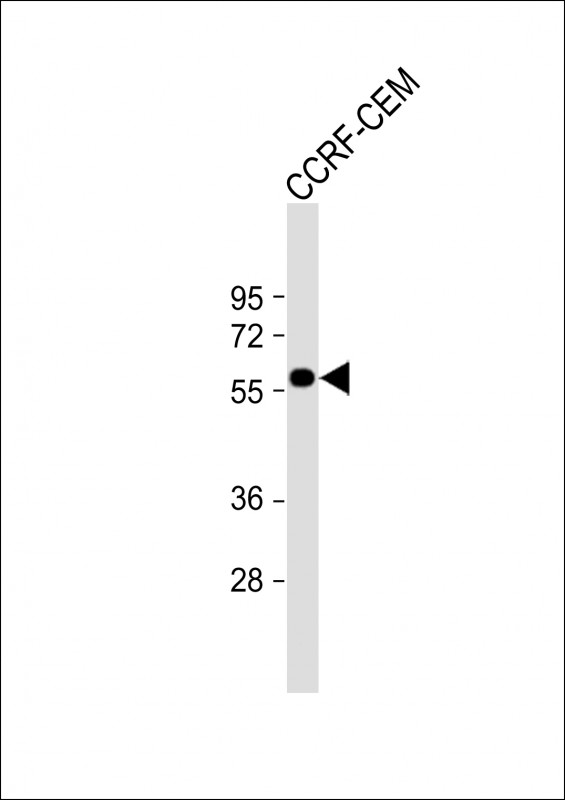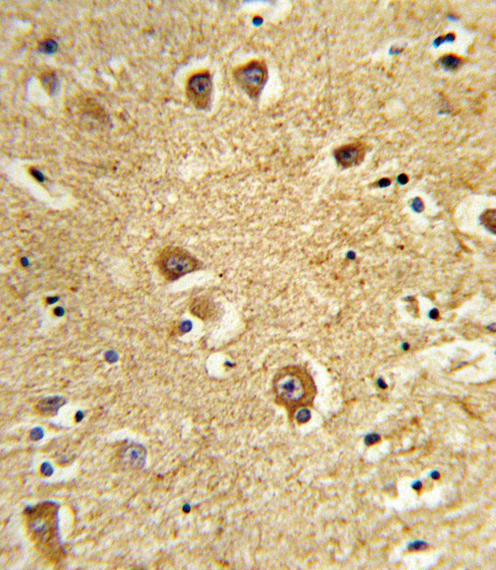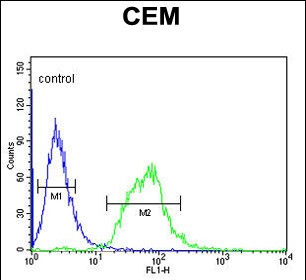SLC22A6 Antibody (C-Term)
Affinity Purified Rabbit Polyclonal Antibody (Pab)
- 产品详情
- 实验流程
- 背景知识
Application
| IHC-P, FC, WB, E |
|---|---|
| Primary Accession | Q4U2R8 |
| Other Accession | NP_004781 |
| Reactivity | Human |
| Host | Rabbit |
| Clonality | Polyclonal |
| Isotype | Rabbit IgG |
| Calculated MW | 61816 Da |
| Antigen Region | 513-541 aa |
| Gene ID | 9356 |
|---|---|
| Other Names | Solute carrier family 22 member 6, Organic anion transporter 1, hOAT1, PAH transporter, hPAHT, Renal organic anion transporter 1, hROAT1, SLC22A6, OAT1, PAHT |
| Target/Specificity | This SLC22A6 antibody is generated from rabbits immunized with a KLH conjugated synthetic peptide between 513-541 amino acids from the C-terminal region of human SLC22A6. |
| Dilution | IHC-P~~1:100~500 FC~~1:10~50 WB~~1:1000 E~~Use at an assay dependent concentration. |
| Format | Purified polyclonal antibody supplied in PBS with 0.09% (W/V) sodium azide. This antibody is purified through a protein A column, followed by peptide affinity purification. |
| Storage | Maintain refrigerated at 2-8°C for up to 2 weeks. For long term storage store at -20°C in small aliquots to prevent freeze-thaw cycles. |
| Precautions | SLC22A6 Antibody (C-Term) is for research use only and not for use in diagnostic or therapeutic procedures. |
| Name | SLC22A6 (HGNC:10970) |
|---|---|
| Synonyms | OAT1, PAHT |
| Function | Secondary active transporter that functions as a Na(+)- independent organic anion (OA)/dicarboxylate antiporter where the uptake of one molecule of OA into the cell is coupled with an efflux of one molecule of intracellular dicarboxylate such as 2-oxoglutarate or glutarate (PubMed:11669456, PubMed:11907186, PubMed:14675047, PubMed:22108572, PubMed:23832370, PubMed:28534121, PubMed:9950961). Mediates the uptake of OA across the basolateral side of proximal tubule epithelial cells, thereby contributing to the renal elimination of endogenous OA from the systemic circulation into the urine (PubMed:9887087). Functions as a biopterin transporters involved in the uptake and the secretion of coenzymes tetrahydrobiopterin (BH4), dihydrobiopterin (BH2) and sepiapterin to urine, thereby determining baseline levels of blood biopterins (PubMed:28534121). Transports prostaglandin E2 (PGE2) and prostaglandin F2-alpha (PGF2-alpha) and may contribute to their renal excretion (PubMed:11907186). Also mediates the uptake of cyclic nucleotides such as cAMP and cGMP (PubMed:26377792). Involved in the transport of neuroactive tryptophan metabolites kynurenate (KYNA) and xanthurenate (XA) and may contribute to their secretion from the brain (PubMed:22108572, PubMed:23832370). May transport glutamate (PubMed:26377792). Also involved in the disposition of uremic toxins and potentially toxic xenobiotics by the renal organic anion secretory pathway, helping reduce their undesired toxicological effects on the body (PubMed:11669456, PubMed:14675047). Uremic toxins include the indoxyl sulfate (IS), hippurate/N- benzoylglycine (HA), indole acetate (IA), 3-carboxy-4- methyl-5-propyl- 2-furanpropionate (CMPF) and urate (PubMed:14675047, PubMed:26377792). Xenobiotics include the mycotoxin ochratoxin (OTA) (PubMed:11669456). May also contribute to the transport of organic compounds in testes across the blood-testis-barrier (PubMed:35307651). |
| Cellular Location | Basolateral cell membrane; Multi-pass membrane protein. Basal cell membrane; Multi-pass membrane protein. Note=Localized to the basolateral membrane of renal proximal tubular cells (PubMed:9887087) Localized to the basal membrane of Sertoli cells (PubMed:35307651) |
| Tissue Location | Strongly expressed in kidney (PubMed:10049739, PubMed:10462545, PubMed:10964714, PubMed:9887087, PubMed:9950961) Expressed at lower level in liver, skeletal muscle, brain and placenta (PubMed:10049739, PubMed:10462545, PubMed:9887087, PubMed:9950961). In kidney, found at the basolateral membrane of the proximal tubule (PubMed:9887087). In testis, primarily localized to the basal membrane of Sertoli cells and weakly expressed in Leydig cells and vascular endothelial cells (PubMed:35307651). |
Research Areas
For Research Use Only. Not For Use In Diagnostic Procedures.
Application Protocols
Provided below are standard protocols that you may find useful for product applications.
BACKGROUND
The protein is involved in the sodium-dependent transport and excretion of organic anions, some of which are potentially toxic. The encoded protein is an integral membrane protein and may be localized to the basolateral membrane.
REFERENCES
Hong,M., et.al, J. Pharmacol. Exp. Ther. 332 (2), 650-658 (2010)
Shin,H.J., et.al, Clin. Chim. Acta 411 (1-2), 99-105 (2010)
终于等到您。ABCEPTA(百远生物)抗体产品。
点击下方“我要评价 ”按钮提交您的反馈信息,您的反馈和评价是我们最宝贵的财富之一,
我们将在1-3个工作日内处理您的反馈信息。
如有疑问,联系:0512-88856768 tech-china@abcepta.com.
¥ 1,250.00
Cat# AP9237B























 癌症的基本特征包括细胞增殖、血管生成、迁移、凋亡逃避机制和细胞永生等。找到癌症发生过程中这些通路的关键标记物和对应的抗体用于检测至关重要。
癌症的基本特征包括细胞增殖、血管生成、迁移、凋亡逃避机制和细胞永生等。找到癌症发生过程中这些通路的关键标记物和对应的抗体用于检测至关重要。 为您推荐一个泛素化位点预测神器——泛素化分析工具,可以为您的蛋白的泛素化位点作出预测和评分。
为您推荐一个泛素化位点预测神器——泛素化分析工具,可以为您的蛋白的泛素化位点作出预测和评分。 细胞自噬受体图形绘图工具为你的蛋白的细胞受体结合位点作出预测和评分,识别结合到自噬通路中的蛋白是非常重要的,便于让我们理解自噬在正常生理、病理过程中的作用,如发育、细胞分化、神经退化性疾病、压力条件下、感染和癌症。
细胞自噬受体图形绘图工具为你的蛋白的细胞受体结合位点作出预测和评分,识别结合到自噬通路中的蛋白是非常重要的,便于让我们理解自噬在正常生理、病理过程中的作用,如发育、细胞分化、神经退化性疾病、压力条件下、感染和癌症。








